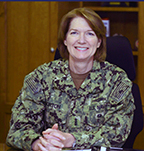
As stated by U.S. Navy Vice Admiral Nancy A. Norton, the director of the Defense Information Systems Agency (DISA), the agency needs to "set the globe."

U.S. Navy Vice Admiral Nancy A. Norton, the director of DISA.
“Setting the globe” means anticipating warfighters’ future needs and approaching the agency’s combat support mission with global mindset instead of a theater-specific strategy. This planning method aligns with the joint force readiness requirements laid out in the 2018 National Defense Strategy (NDS) and the DoD Cyber Strategy, said Norton.
During the past 18 months, DISA’s Operations Center has led an agency-wide effort to examine DISA’s ability to support the warfighter against a near-peer competitor in an all-domain, trans-regional fight, said DISA’s chief of plans, Army Lieutenant Colonel Blair Sawyer. Sawyer said DISA is currently involved in four major planning efforts supporting two combatant commands and said the agency has largely provided analysis and products to support the new globally integrated campaign and contingency planning concept directed by the Chairman of the Joint Chiefs of Staff.
This new planning concept helps integrate the joint force for engagement with long-term strategic competitors, principally China and Russia — as well as other competitors, such as North Korea, Iran, and violent extremist organizations. It also defines proposed tactics to fight and win global conflicts in the future. Developing these plans requires a holistic and integrated review process designed to improve unity of effort and mission assurance, while shifting the focus of planning from theater-specific to a global problem-focused approach, said Sawyer. He then commented that transitioning to this proactive thought process is especially important in today’s environment. Continuously advancing technologies have signaled a paradigm shift in how battles and future wars are fought and won — the agency must shift with them.
Sawyer noted that DISA primarily builds its customers’ peacetime capabilities for day-to-day command and control. The agency's mission now is to go to those customers and ask, ‘What will you need in regard to these capabilities in a wartime environment?’ For example, if a command processes 400,000 emails worth of data each day across the theater in peacetime, then this requirement will drastically increase in a wartime environment.
Adapting to those changing needs is one of the top priorities laid out in the NDS, said Chairman of the Joint Chiefs of Staff Marine Corps General Joseph Dunford at a speaking engagement in 2018. The general also said part of his tenure has been focused on developing tools to combat cyber threats and that he is, “Somebody who is never complacent with where we are," adding that in order for the military to be successful, the ability to project power to an area is critical... then, once there, maneuvering across all domains.. sea, air, land, space, and cyberspace, is crucial.
To ensure the latter, DISA is linking the business development side of DISA to the planning side, said Phil La Perla, civilian deputy of the cyber operations directorate. He added that bringing all the planners together in a joint planning group gives everyone a common operational picture and situational awareness for warfighter requirements.

